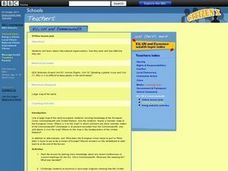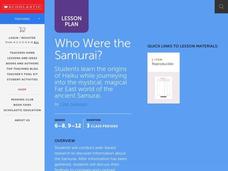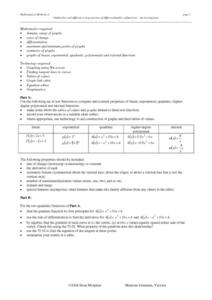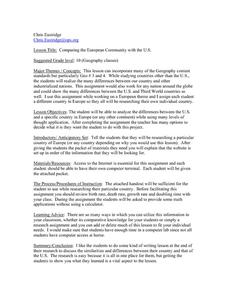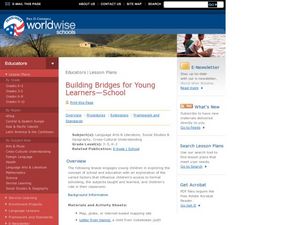Curated OER
Mapping Perceptions of China
Students discuss what types of things are included on a map. They compare and contrast maps of China with a map they create and practice using different types of maps. They write analysis of their classmates maps.
BBC
Eu, Un, and Commonwealth: Keeping Peace
What are the UN, the EU, and Commonwealth? Have the class brainstorm all they know about these powerful international organizations. Then have them compare and contrast the ways in which different countries or political groups work. They...
Curated OER
Citizenship
Students investigate patterns of immigration in the US while comparing and contrasting the ideas of citizenship and non-citizenship. They decide how education plays a role in citizenship.
Curated OER
Who Were the Samurai?
Learners research Samurai using the Internet. They compare and contrast the research information with each other.
Texas Instruments
Classifying Functions
Learners explore linear, quadratic, and exponential functions in this activity that makes use of TI Navigator and TI Plus calculators. Using the technology, learners compare and contrast the three types of functions given in the activity.
Curated OER
Similarities and Differences in Properties of Different Families of Functions - An Investigation
Exploring families of functions allows students compare and contrast properties of functions. Students discuss properties that include symmetry, max and min points, asymptotes, derivatives, etc.
Curated OER
Leaks and Gossip: Examining WikiLeaks Through Political Cartoons
Use political cartoons to spice up a discussion on national security! Two cartoons, one by Normal Rockwell in 1948, the other a parody of Rockwell's by Chuck Asay in 2010, depict the dangers of leaking information. Background information...
Curated OER
Comparing the European Community with the U.S.
Learners research a country to compare with the U.S. In this compare/contrast lesson, students research the CIA World Factbook research a European country's characteristics. Learners calculate growth rate and doubling time and examine...
Peace Corps
Community
What is a community? Find out with a lesson that sheds light onto the different types of communities—school, local, and global. Scholars read informational text detailing the life of a young girl from Cape Verde and take part in a...
Peace Corps
Family
Family traditions are the focus of a instructional activity that explores the lives of children in India and those in your classroom. Scholars examine their own family roles and traditions, then respond to an informative text detailing a...
MENSA Education & Research Foundation
Ecosystems
Explore the Earth's different ecosystems through four lessons, an assessment, and extension activities. Lessons include informative text and step-by-step instructions to apply knowledge in interactive, and thought provoking ways; such as...
It's About Time
Organic Substances
Host an exciting lab in which learners burn fruit rinds to better understand hydrocarbons. A reading passage and analysis questions wrap up the lesson.
Curated OER
Homes for Native Nations
Students define native and research natives from their country. In groups, they choose four nations and study the homes in the area, the landscape, and types of buildings. After discussing the meaning of a family, students illustrate...
Curated OER
Far and Near
Learners compare and contrast their life to that of children in Africa. In this multicultural instructional activity, students read the book A Country Far Away and list ways that their life is similar to the children in Africa.
Curated OER
Le Monde Francophone
Seventh graders discover the variety of French Speaking Countries worldwide. They discover, compare and contrast some distinguishing features of those areas. Students complete several worksheets within this instructional activity.
Curated OER
Compare and Contrast Composers
Students identify various pieces of music that are familiar to them and define how the music made them feel. Then they select their favorite piece of music heard and the activities in which they like to do. Students also attend a...
Curated OER
Why Not Visit My Country?
Students research a country using the Travel Languages Web site. Using MS Publisher, they create a travel flyer about the country. Using Inspiration, they develop a concept map of what they learned about their country.
Curated OER
Building Bridges for Young Learners- School
Young scholars examine the purpose of education. In this schooling lesson, students read a letter from a child in Uzbekistan. Young scholars compare and contrast their schooling to children around the world.
Curated OER
Building Bridges for Young Learners--Culture
Young scholars explore the concept of "culture." In this cross curriculum literacy and world history lesson, students listen to a letter written by a child from Namibia, then compare and contrast life in Africa with their own life. Young...
Curated OER
Health and Nutrition
Students examine vocabulary words that deal with the parts of the body. They identify the body parts and organs associated with the five senses. They identify common illnesses, causes and treatments. They research various lifestyle...
Curated OER
Amidst the Rubble of Ruined Cities
Students, in committees, develop and propose solutions to rebuild various elements of Colombia's infrastructure in the wake of the January 25, 1999 earthquake, as well as compare and contrast the earthquake's affects on Colombia to an...
Curated OER
Survey Says...
High schoolers examine Iraqi polls concerning the quality of life in their country. After exploring methodologies of taking polls and surveys, the compare and contrast the findings of two surveys. Students develop research questions,...
Curated OER
Consider the Source
Young scholars explain how to critically compare news reporting from around the world, focusing on coverage of the Taliban regime. They compare and contrast television and print media reporting on the issue.
Curated OER
How Women Got the Vote: The Story of Carrie Lane Chapman Catt
Students participate in a simulation and compare and contrast the arguments for and against womens' right to vote. In this civil rights lesson, students simulate disenfranchisement of women by allowing only half of the class to vote on a...



